Lewin's 3-Stage Model: A Detailed Analysis of Change Management
VerifiedAdded on 2023/06/10
|7
|1533
|318
Essay
AI Summary
This essay provides a comprehensive analysis of Kurt Lewin's 3-stage change management model, a widely recognized framework for implementing organizational change. The essay begins by introducing the model and situating it within the broader context of change management literature. It then delves into a detailed discussion of the model's three stages: unfreezing, changing, and refreezing, providing definitions, descriptions, and insights from various authors. The essay also presents a critical evaluation of the model, highlighting its disadvantages and limitations, including arguments against its effectiveness in today's dynamic business environment. It explores concerns about the model's potential to overlook human feelings, impact long-term goals, and increase employee turnover. The essay concludes by summarizing the key findings and reinforcing the significance of Lewin's model while acknowledging its limitations and the importance of transparency and employee involvement in the change process. Desklib offers a variety of resources, including similar essays and solved assignments, to aid students in their studies.
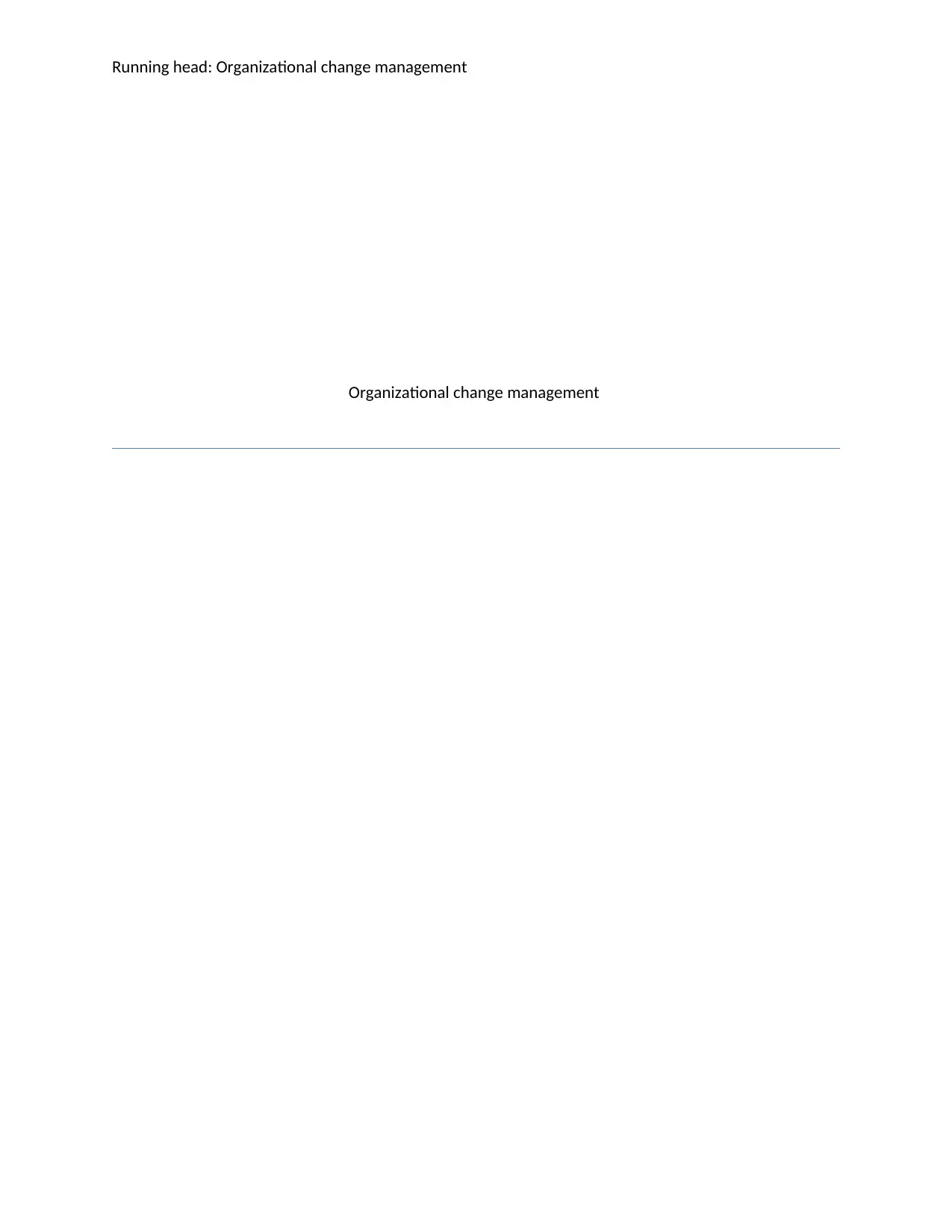
Running head: Organizational change management
Organizational change management
Organizational change management
Paraphrase This Document
Need a fresh take? Get an instant paraphrase of this document with our AI Paraphraser
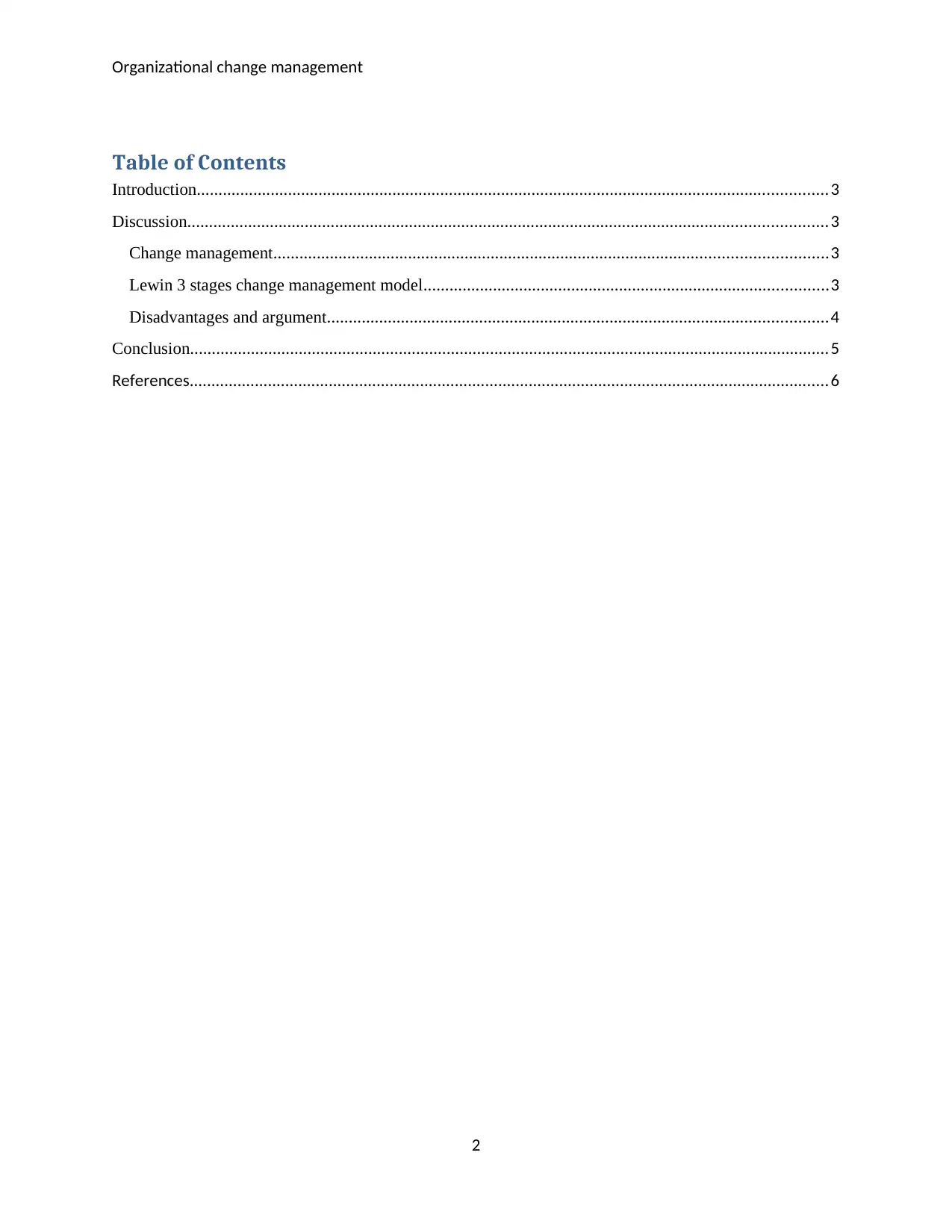
Organizational change management
Table of Contents
Introduction.................................................................................................................................................3
Discussion...................................................................................................................................................3
Change management...............................................................................................................................3
Lewin 3 stages change management model.............................................................................................3
Disadvantages and argument...................................................................................................................4
Conclusion...................................................................................................................................................5
References...................................................................................................................................................6
2
Table of Contents
Introduction.................................................................................................................................................3
Discussion...................................................................................................................................................3
Change management...............................................................................................................................3
Lewin 3 stages change management model.............................................................................................3
Disadvantages and argument...................................................................................................................4
Conclusion...................................................................................................................................................5
References...................................................................................................................................................6
2
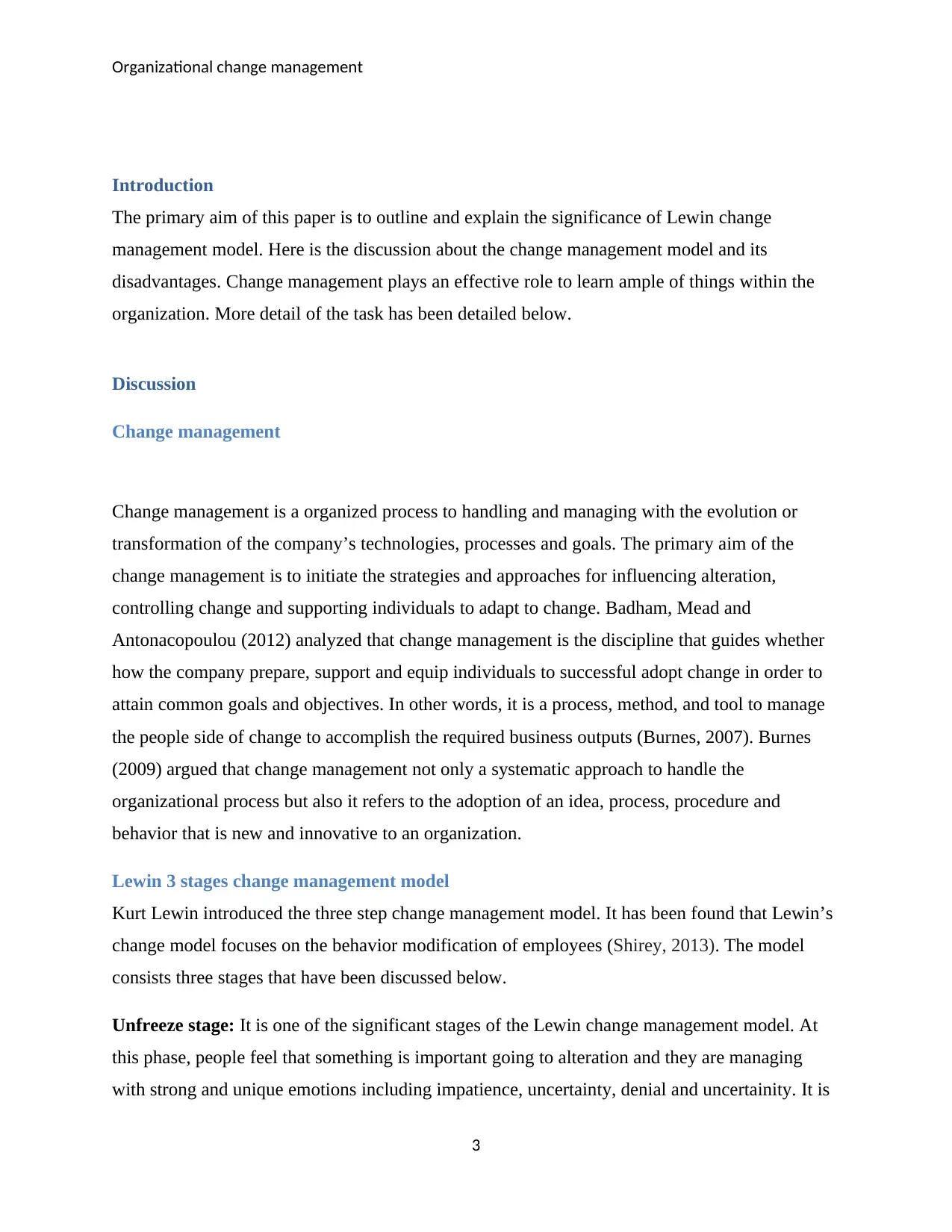
Organizational change management
Introduction
The primary aim of this paper is to outline and explain the significance of Lewin change
management model. Here is the discussion about the change management model and its
disadvantages. Change management plays an effective role to learn ample of things within the
organization. More detail of the task has been detailed below.
Discussion
Change management
Change management is a organized process to handling and managing with the evolution or
transformation of the company’s technologies, processes and goals. The primary aim of the
change management is to initiate the strategies and approaches for influencing alteration,
controlling change and supporting individuals to adapt to change. Badham, Mead and
Antonacopoulou (2012) analyzed that change management is the discipline that guides whether
how the company prepare, support and equip individuals to successful adopt change in order to
attain common goals and objectives. In other words, it is a process, method, and tool to manage
the people side of change to accomplish the required business outputs (Burnes, 2007). Burnes
(2009) argued that change management not only a systematic approach to handle the
organizational process but also it refers to the adoption of an idea, process, procedure and
behavior that is new and innovative to an organization.
Lewin 3 stages change management model
Kurt Lewin introduced the three step change management model. It has been found that Lewin’s
change model focuses on the behavior modification of employees (Shirey, 2013). The model
consists three stages that have been discussed below.
Unfreeze stage: It is one of the significant stages of the Lewin change management model. At
this phase, people feel that something is important going to alteration and they are managing
with strong and unique emotions including impatience, uncertainty, denial and uncertainity. It is
3
Introduction
The primary aim of this paper is to outline and explain the significance of Lewin change
management model. Here is the discussion about the change management model and its
disadvantages. Change management plays an effective role to learn ample of things within the
organization. More detail of the task has been detailed below.
Discussion
Change management
Change management is a organized process to handling and managing with the evolution or
transformation of the company’s technologies, processes and goals. The primary aim of the
change management is to initiate the strategies and approaches for influencing alteration,
controlling change and supporting individuals to adapt to change. Badham, Mead and
Antonacopoulou (2012) analyzed that change management is the discipline that guides whether
how the company prepare, support and equip individuals to successful adopt change in order to
attain common goals and objectives. In other words, it is a process, method, and tool to manage
the people side of change to accomplish the required business outputs (Burnes, 2007). Burnes
(2009) argued that change management not only a systematic approach to handle the
organizational process but also it refers to the adoption of an idea, process, procedure and
behavior that is new and innovative to an organization.
Lewin 3 stages change management model
Kurt Lewin introduced the three step change management model. It has been found that Lewin’s
change model focuses on the behavior modification of employees (Shirey, 2013). The model
consists three stages that have been discussed below.
Unfreeze stage: It is one of the significant stages of the Lewin change management model. At
this phase, people feel that something is important going to alteration and they are managing
with strong and unique emotions including impatience, uncertainty, denial and uncertainity. It is
3
⊘ This is a preview!⊘
Do you want full access?
Subscribe today to unlock all pages.

Trusted by 1+ million students worldwide
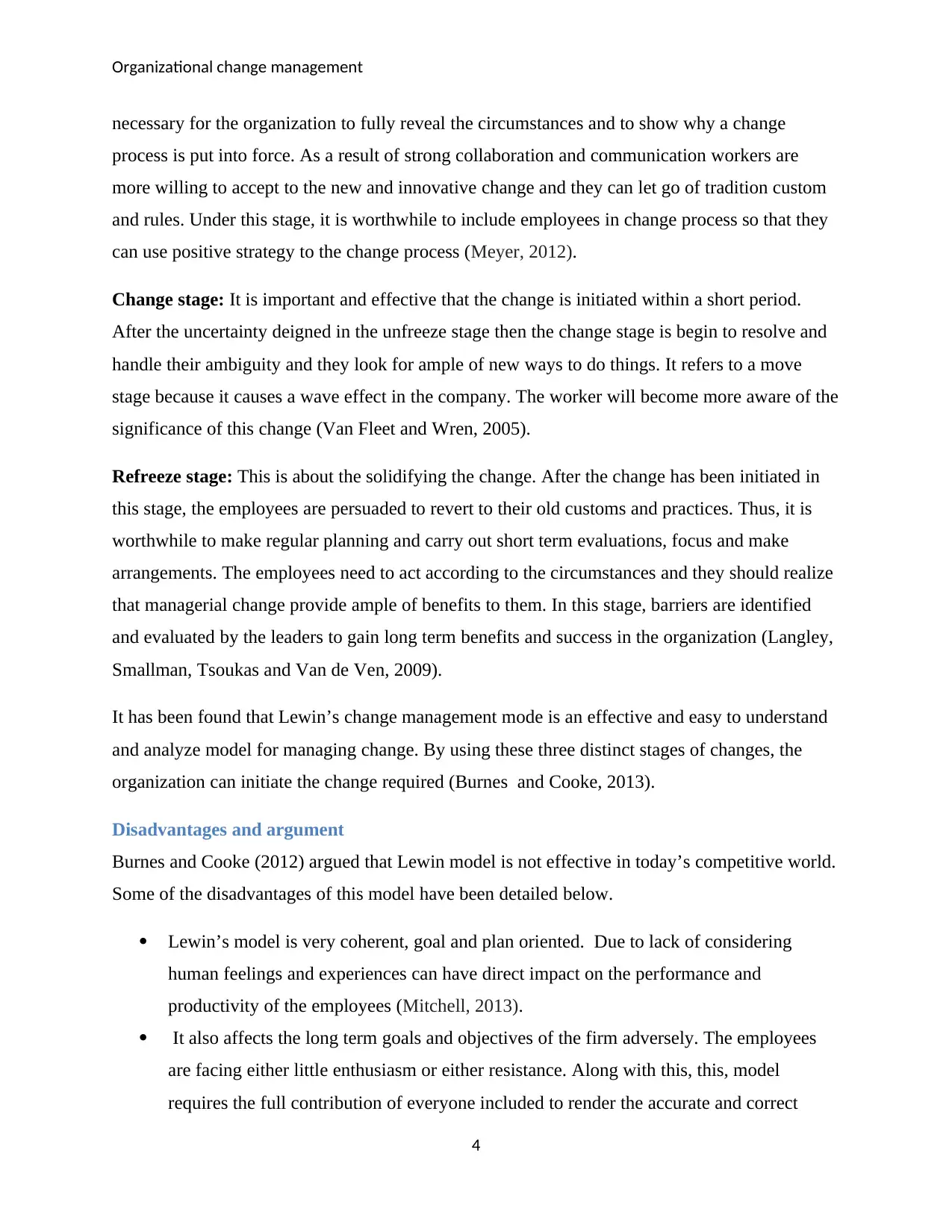
Organizational change management
necessary for the organization to fully reveal the circumstances and to show why a change
process is put into force. As a result of strong collaboration and communication workers are
more willing to accept to the new and innovative change and they can let go of tradition custom
and rules. Under this stage, it is worthwhile to include employees in change process so that they
can use positive strategy to the change process (Meyer, 2012).
Change stage: It is important and effective that the change is initiated within a short period.
After the uncertainty deigned in the unfreeze stage then the change stage is begin to resolve and
handle their ambiguity and they look for ample of new ways to do things. It refers to a move
stage because it causes a wave effect in the company. The worker will become more aware of the
significance of this change (Van Fleet and Wren, 2005).
Refreeze stage: This is about the solidifying the change. After the change has been initiated in
this stage, the employees are persuaded to revert to their old customs and practices. Thus, it is
worthwhile to make regular planning and carry out short term evaluations, focus and make
arrangements. The employees need to act according to the circumstances and they should realize
that managerial change provide ample of benefits to them. In this stage, barriers are identified
and evaluated by the leaders to gain long term benefits and success in the organization (Langley,
Smallman, Tsoukas and Van de Ven, 2009).
It has been found that Lewin’s change management mode is an effective and easy to understand
and analyze model for managing change. By using these three distinct stages of changes, the
organization can initiate the change required (Burnes and Cooke, 2013).
Disadvantages and argument
Burnes and Cooke (2012) argued that Lewin model is not effective in today’s competitive world.
Some of the disadvantages of this model have been detailed below.
Lewin’s model is very coherent, goal and plan oriented. Due to lack of considering
human feelings and experiences can have direct impact on the performance and
productivity of the employees (Mitchell, 2013).
It also affects the long term goals and objectives of the firm adversely. The employees
are facing either little enthusiasm or either resistance. Along with this, this, model
requires the full contribution of everyone included to render the accurate and correct
4
necessary for the organization to fully reveal the circumstances and to show why a change
process is put into force. As a result of strong collaboration and communication workers are
more willing to accept to the new and innovative change and they can let go of tradition custom
and rules. Under this stage, it is worthwhile to include employees in change process so that they
can use positive strategy to the change process (Meyer, 2012).
Change stage: It is important and effective that the change is initiated within a short period.
After the uncertainty deigned in the unfreeze stage then the change stage is begin to resolve and
handle their ambiguity and they look for ample of new ways to do things. It refers to a move
stage because it causes a wave effect in the company. The worker will become more aware of the
significance of this change (Van Fleet and Wren, 2005).
Refreeze stage: This is about the solidifying the change. After the change has been initiated in
this stage, the employees are persuaded to revert to their old customs and practices. Thus, it is
worthwhile to make regular planning and carry out short term evaluations, focus and make
arrangements. The employees need to act according to the circumstances and they should realize
that managerial change provide ample of benefits to them. In this stage, barriers are identified
and evaluated by the leaders to gain long term benefits and success in the organization (Langley,
Smallman, Tsoukas and Van de Ven, 2009).
It has been found that Lewin’s change management mode is an effective and easy to understand
and analyze model for managing change. By using these three distinct stages of changes, the
organization can initiate the change required (Burnes and Cooke, 2013).
Disadvantages and argument
Burnes and Cooke (2012) argued that Lewin model is not effective in today’s competitive world.
Some of the disadvantages of this model have been detailed below.
Lewin’s model is very coherent, goal and plan oriented. Due to lack of considering
human feelings and experiences can have direct impact on the performance and
productivity of the employees (Mitchell, 2013).
It also affects the long term goals and objectives of the firm adversely. The employees
are facing either little enthusiasm or either resistance. Along with this, this, model
requires the full contribution of everyone included to render the accurate and correct
4
Paraphrase This Document
Need a fresh take? Get an instant paraphrase of this document with our AI Paraphraser
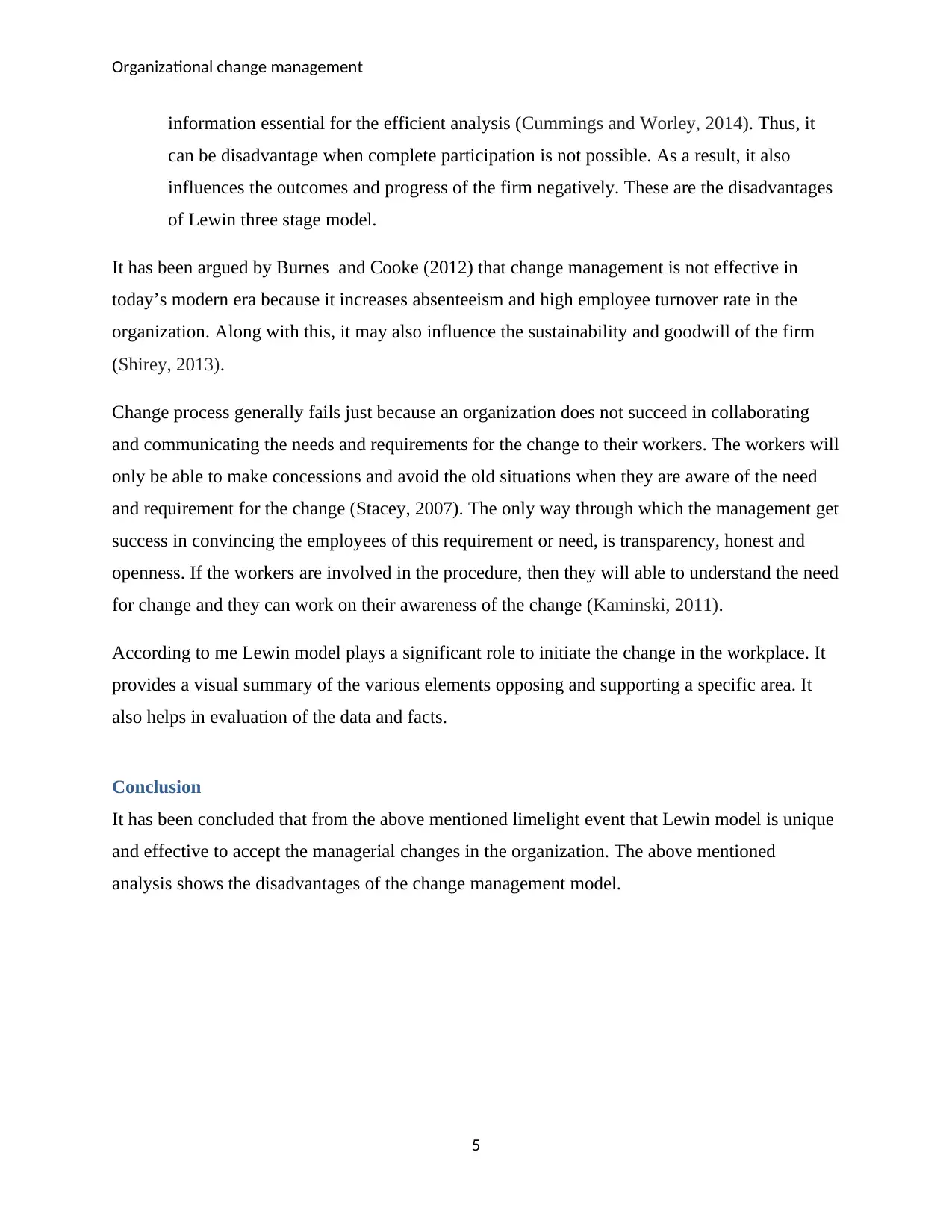
Organizational change management
information essential for the efficient analysis (Cummings and Worley, 2014). Thus, it
can be disadvantage when complete participation is not possible. As a result, it also
influences the outcomes and progress of the firm negatively. These are the disadvantages
of Lewin three stage model.
It has been argued by Burnes and Cooke (2012) that change management is not effective in
today’s modern era because it increases absenteeism and high employee turnover rate in the
organization. Along with this, it may also influence the sustainability and goodwill of the firm
(Shirey, 2013).
Change process generally fails just because an organization does not succeed in collaborating
and communicating the needs and requirements for the change to their workers. The workers will
only be able to make concessions and avoid the old situations when they are aware of the need
and requirement for the change (Stacey, 2007). The only way through which the management get
success in convincing the employees of this requirement or need, is transparency, honest and
openness. If the workers are involved in the procedure, then they will able to understand the need
for change and they can work on their awareness of the change (Kaminski, 2011).
According to me Lewin model plays a significant role to initiate the change in the workplace. It
provides a visual summary of the various elements opposing and supporting a specific area. It
also helps in evaluation of the data and facts.
Conclusion
It has been concluded that from the above mentioned limelight event that Lewin model is unique
and effective to accept the managerial changes in the organization. The above mentioned
analysis shows the disadvantages of the change management model.
5
information essential for the efficient analysis (Cummings and Worley, 2014). Thus, it
can be disadvantage when complete participation is not possible. As a result, it also
influences the outcomes and progress of the firm negatively. These are the disadvantages
of Lewin three stage model.
It has been argued by Burnes and Cooke (2012) that change management is not effective in
today’s modern era because it increases absenteeism and high employee turnover rate in the
organization. Along with this, it may also influence the sustainability and goodwill of the firm
(Shirey, 2013).
Change process generally fails just because an organization does not succeed in collaborating
and communicating the needs and requirements for the change to their workers. The workers will
only be able to make concessions and avoid the old situations when they are aware of the need
and requirement for the change (Stacey, 2007). The only way through which the management get
success in convincing the employees of this requirement or need, is transparency, honest and
openness. If the workers are involved in the procedure, then they will able to understand the need
for change and they can work on their awareness of the change (Kaminski, 2011).
According to me Lewin model plays a significant role to initiate the change in the workplace. It
provides a visual summary of the various elements opposing and supporting a specific area. It
also helps in evaluation of the data and facts.
Conclusion
It has been concluded that from the above mentioned limelight event that Lewin model is unique
and effective to accept the managerial changes in the organization. The above mentioned
analysis shows the disadvantages of the change management model.
5
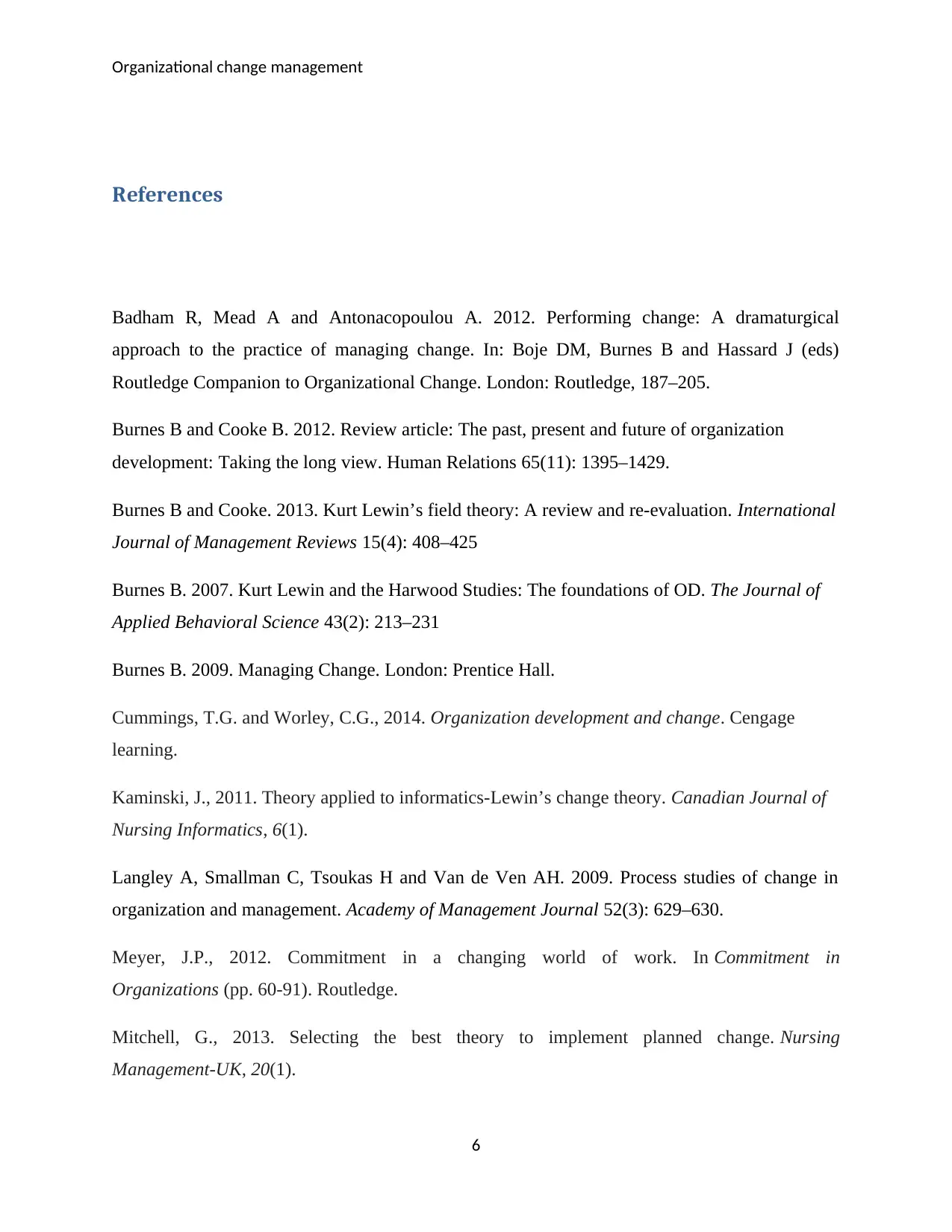
Organizational change management
References
Badham R, Mead A and Antonacopoulou A. 2012. Performing change: A dramaturgical
approach to the practice of managing change. In: Boje DM, Burnes B and Hassard J (eds)
Routledge Companion to Organizational Change. London: Routledge, 187–205.
Burnes B and Cooke B. 2012. Review article: The past, present and future of organization
development: Taking the long view. Human Relations 65(11): 1395–1429.
Burnes B and Cooke. 2013. Kurt Lewin’s field theory: A review and re-evaluation. International
Journal of Management Reviews 15(4): 408–425
Burnes B. 2007. Kurt Lewin and the Harwood Studies: The foundations of OD. The Journal of
Applied Behavioral Science 43(2): 213–231
Burnes B. 2009. Managing Change. London: Prentice Hall.
Cummings, T.G. and Worley, C.G., 2014. Organization development and change. Cengage
learning.
Kaminski, J., 2011. Theory applied to informatics-Lewin’s change theory. Canadian Journal of
Nursing Informatics, 6(1).
Langley A, Smallman C, Tsoukas H and Van de Ven AH. 2009. Process studies of change in
organization and management. Academy of Management Journal 52(3): 629–630.
Meyer, J.P., 2012. Commitment in a changing world of work. In Commitment in
Organizations (pp. 60-91). Routledge.
Mitchell, G., 2013. Selecting the best theory to implement planned change. Nursing
Management-UK, 20(1).
6
References
Badham R, Mead A and Antonacopoulou A. 2012. Performing change: A dramaturgical
approach to the practice of managing change. In: Boje DM, Burnes B and Hassard J (eds)
Routledge Companion to Organizational Change. London: Routledge, 187–205.
Burnes B and Cooke B. 2012. Review article: The past, present and future of organization
development: Taking the long view. Human Relations 65(11): 1395–1429.
Burnes B and Cooke. 2013. Kurt Lewin’s field theory: A review and re-evaluation. International
Journal of Management Reviews 15(4): 408–425
Burnes B. 2007. Kurt Lewin and the Harwood Studies: The foundations of OD. The Journal of
Applied Behavioral Science 43(2): 213–231
Burnes B. 2009. Managing Change. London: Prentice Hall.
Cummings, T.G. and Worley, C.G., 2014. Organization development and change. Cengage
learning.
Kaminski, J., 2011. Theory applied to informatics-Lewin’s change theory. Canadian Journal of
Nursing Informatics, 6(1).
Langley A, Smallman C, Tsoukas H and Van de Ven AH. 2009. Process studies of change in
organization and management. Academy of Management Journal 52(3): 629–630.
Meyer, J.P., 2012. Commitment in a changing world of work. In Commitment in
Organizations (pp. 60-91). Routledge.
Mitchell, G., 2013. Selecting the best theory to implement planned change. Nursing
Management-UK, 20(1).
6
⊘ This is a preview!⊘
Do you want full access?
Subscribe today to unlock all pages.

Trusted by 1+ million students worldwide
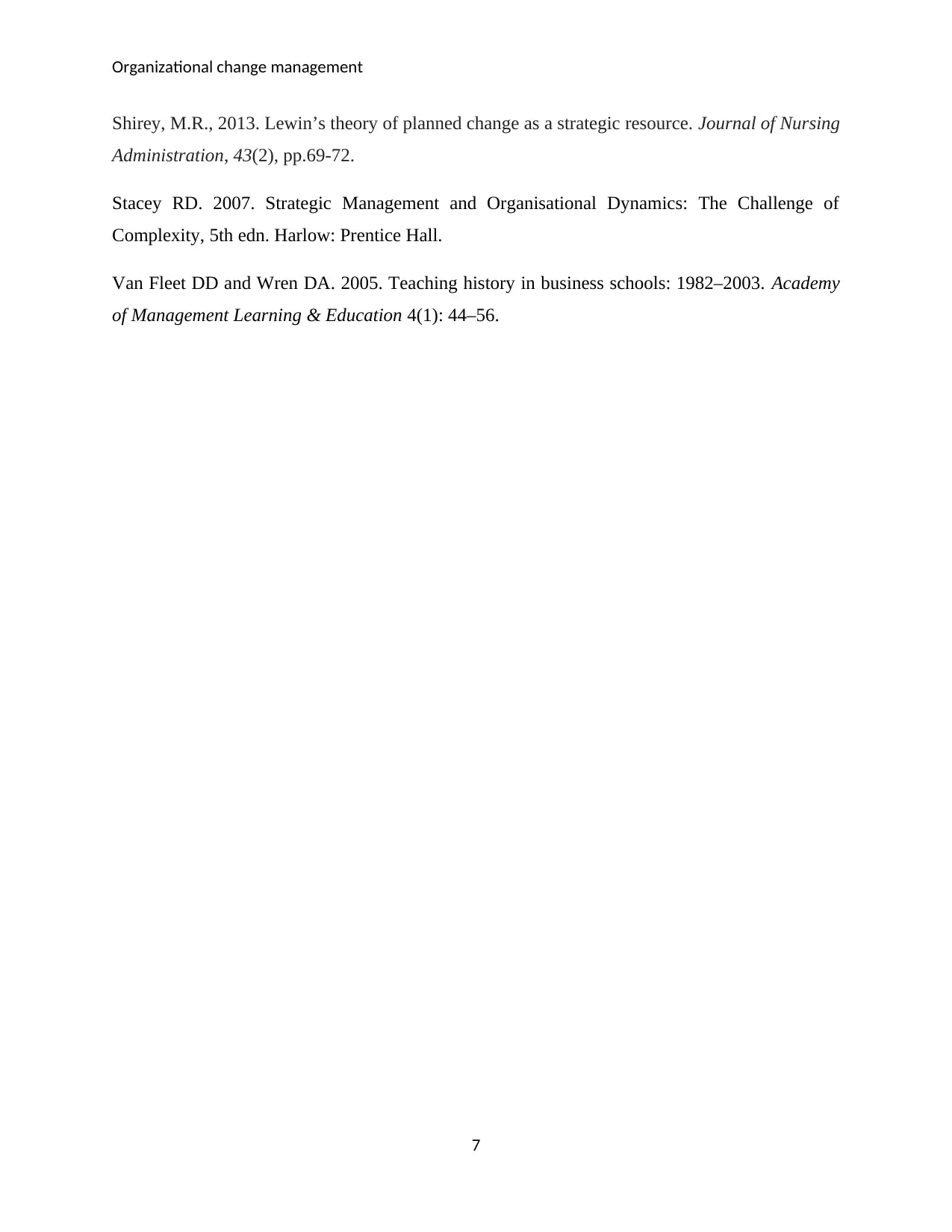
Organizational change management
Shirey, M.R., 2013. Lewin’s theory of planned change as a strategic resource. Journal of Nursing
Administration, 43(2), pp.69-72.
Stacey RD. 2007. Strategic Management and Organisational Dynamics: The Challenge of
Complexity, 5th edn. Harlow: Prentice Hall.
Van Fleet DD and Wren DA. 2005. Teaching history in business schools: 1982–2003. Academy
of Management Learning & Education 4(1): 44–56.
7
Shirey, M.R., 2013. Lewin’s theory of planned change as a strategic resource. Journal of Nursing
Administration, 43(2), pp.69-72.
Stacey RD. 2007. Strategic Management and Organisational Dynamics: The Challenge of
Complexity, 5th edn. Harlow: Prentice Hall.
Van Fleet DD and Wren DA. 2005. Teaching history in business schools: 1982–2003. Academy
of Management Learning & Education 4(1): 44–56.
7
1 out of 7
Related Documents
Your All-in-One AI-Powered Toolkit for Academic Success.
+13062052269
info@desklib.com
Available 24*7 on WhatsApp / Email
![[object Object]](/_next/static/media/star-bottom.7253800d.svg)
Unlock your academic potential
Copyright © 2020–2025 A2Z Services. All Rights Reserved. Developed and managed by ZUCOL.





